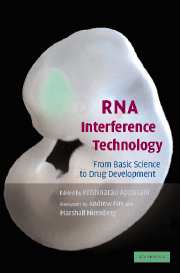Book contents
- Frontmatter
- Contents
- Foreword by Andrew Fire
- Foreword by Marshall Nirenberg
- List of Contributors
- Introduction
- Section one Basic RNAi, siRNA, microRNAs and gene-silencing mechanisms
- Section two Design, synthesis of siRNAs
- Section three Vector development and in vivo, in vitro and in ovo delivery methods
- Section four Gene silencing in model organisms
- Section five Drug target validation
- Section six Therapeutic and drug development
- Section seven High-throughput genome-wide RNAi analysis
- 30 High-throughput RNAi by soaking in Caenorhabtis elegans
- 31 Tools for integrative genomics: Genome-wide RNAi and expression profiling in Drosophila
- 32 Microarray analysis and RNA silencing to determine genes functionally important in mesothelioma
- 33 High-throughput RNA interference
- 34 Generation of highly specific vector-based shRNAi libraries directed against the entire human genome
- Index
- Plate section
- References
32 - Microarray analysis and RNA silencing to determine genes functionally important in mesothelioma
Published online by Cambridge University Press: 31 July 2009
- Frontmatter
- Contents
- Foreword by Andrew Fire
- Foreword by Marshall Nirenberg
- List of Contributors
- Introduction
- Section one Basic RNAi, siRNA, microRNAs and gene-silencing mechanisms
- Section two Design, synthesis of siRNAs
- Section three Vector development and in vivo, in vitro and in ovo delivery methods
- Section four Gene silencing in model organisms
- Section five Drug target validation
- Section six Therapeutic and drug development
- Section seven High-throughput genome-wide RNAi analysis
- 30 High-throughput RNAi by soaking in Caenorhabtis elegans
- 31 Tools for integrative genomics: Genome-wide RNAi and expression profiling in Drosophila
- 32 Microarray analysis and RNA silencing to determine genes functionally important in mesothelioma
- 33 High-throughput RNA interference
- 34 Generation of highly specific vector-based shRNAi libraries directed against the entire human genome
- Index
- Plate section
- References
Summary
Introduction
The most important event in science in this decade has been the publication of the sequence of the human genome by two independent initiatives (Lander et al., 2001; Venter et al., 2001). However, the sequence of the human genome and other species can contribute to our understanding of human biology only if it can be linked with functional information on the roles of encoded proteins. A major goal of science in the “post-genomic era” is to unravel the functions of the many genes discovered by sequencing. Although sequence- or structure-based comparisons are enabling the generation of hypotheses on the biochemical functions of many gene products, determining the role of a large set of genes is still a challenge.
Recently, RNA interference (RNAi) technology has been developed for the down-regulation of selected gene expression in mammalian cells. This technology offers a rapid way to gain insight to loss-of-function phenotypes associated with specific genes. Furthermore, the combination of RNAi with other functional genomic approaches such as gene expression profiling is providing a powerful tool in our efforts to establish the function of genes in the pathogenesis of many diseases. In this chapter, we will summarize the contributions that RNAi and microarrays have had in cancer research, particularly in understanding the mechanisms and pathogenesis of malignant mesothelioma, a devastating tumor of the serosal cells lining the pleural, peritoneal and pericardial cavities (Mossman and Gee, 1989).
- Type
- Chapter
- Information
- RNA Interference TechnologyFrom Basic Science to Drug Development, pp. 447 - 469Publisher: Cambridge University PressPrint publication year: 2005



